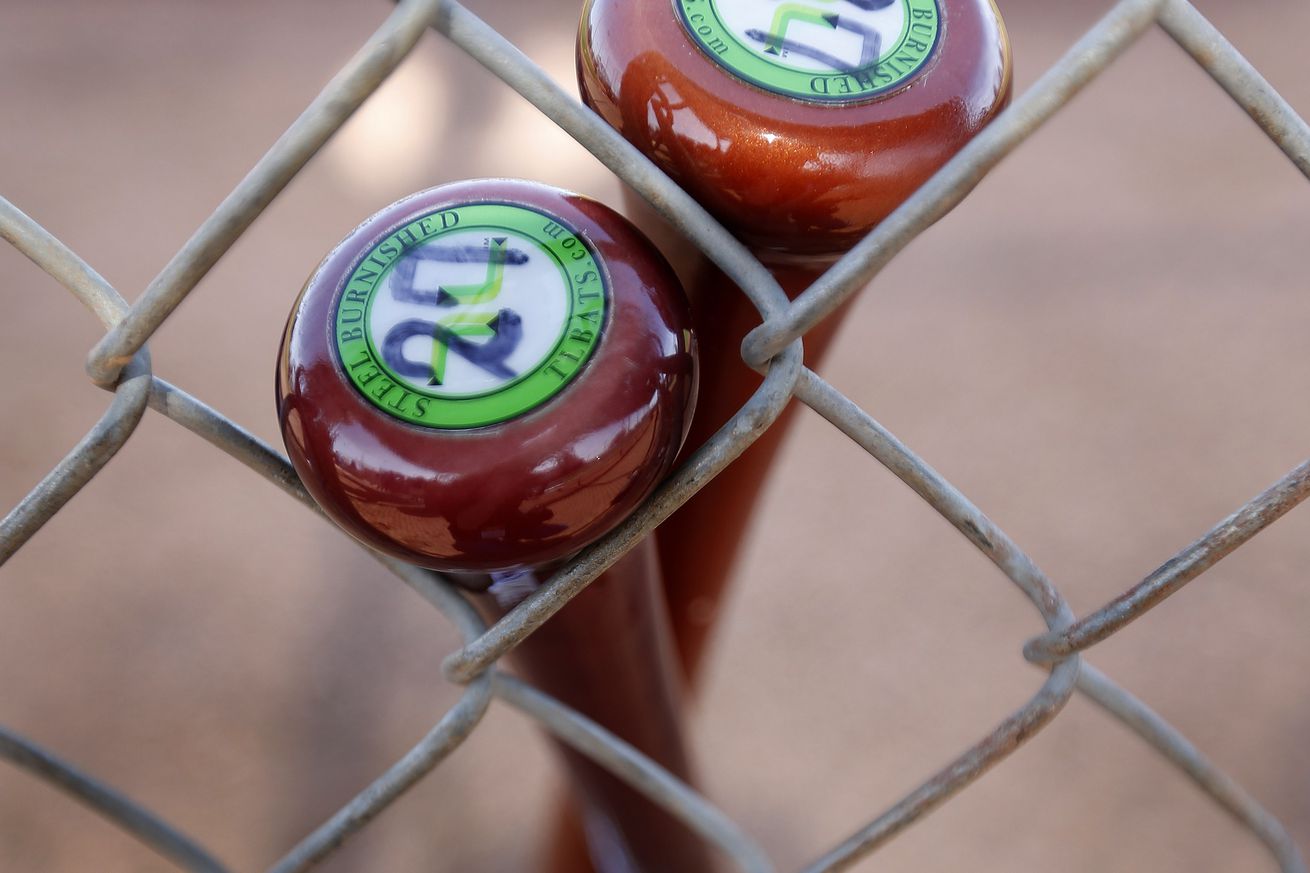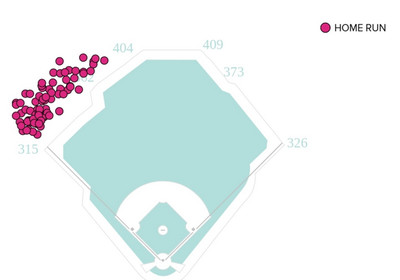
Looking at some new batting analytics at Baseball Savant
Baseball Savant recently released some new bat tracking analytics. You may be aware of the previous bat tracking measures like bat speed. As you might imagine, it turns out that batting mechanics are complicated events to measure. Basically multiple components of the swing are interconnected in determining whether a hitter makes good contact with t he ball.
The new measures are swing path, attack angle, ideal attack angle and attack direction. I relied on Mike Petriello’s article to try to understand these metrics. If you want more detailed information, I recommend that you look at his article. For my article, I will look at what these mew metrics might tell us about Astros’ hitters.
You can follow these metrics for Astros’ hitters at Baseball Savant.
Swing Path
The swing path measures the tilt of the swing path, with a flat swing and an upper cut swing at opposite extremes. The range for more or less steep swings is 20 – 50 degrees, with league average at 32 degrees. This measure of the shape of the swing isn’t necessarily a matter of good or bad swing paths. The type of swing path may simply represent the swing that individual batters feel comfortable with. Good hitters are at both the steeper (Freeman, Judge) and flatter (Carroll and Vlad Guerrero) end of the range. In general terms, a steeper swing might fare better against sinker ball pitchers while a flatter swing might fare better against elevated 4 seam fastballs.
To some extent there is a trade off between contact and power with steeper swings. Petriello’s article indicates that average SLG and wOBA are highest among batters with slightly above average (33 – 38 degrees) tilt. However, the average whiff percent also tends to increase with steeper swings.
Among Astros, the above average tilt hitters are Dezenzo (40), Smith (37), Alvarez (37) Caratini (35), and McCormick (34). Dezenzo’s upper cut swing is among MLB leaders in steep swings. The following batters are average (32) in swing path tilt: Rodgers, Dubon, Paredes, and Meyers. Altuve (29), Walker (29) and Pena (30) exhibit tilt that is slightly below average. Yaiiner Diaz has the flattest swing at 28 degrees.
Pena’s swing tilt has shifted from above average in 2023 (33 degrees) to below average in 2024 and 2025 (29 and 30, respectively). Christian Walker’s swing has been trending toward a flatter swing: 2023 (31), 2024 (30), and 2025 (29). Yainer Diaz has changed to a flatter tilt in 2025 (28) compared to 2023 and 2024 (31 and 30). For Pena and Walker, I don’t know if this reflects a deliberate change in swing path or if pitchers are just pitching them in different quadrants. The reduction in Diaz’s swing path tilt seems significant enough that it probably is based on a deliberate adjustment.
Attack Angle
Attack Angle measures the vertical angle of the bat when it makes contact. The range is 1 – 20 degrees, and a higher angle tends to produce balls in the air and a lower angle usually produce ground balls. Significantly, this measure reflects batter timing, in the sense that a good attack angle means the batter has synched up his swing with the ball’s direction and angle. Batters frequently say,, “I’m working on my timing,” and this measure makes sense in that context.
Astros flyball hitters like McCormick, Paredes, and Dezenzo are at the top of the attack angle leaderboard. Altuve’s attack angle is down a couple of degrees (perhaps his timing isn’t quit there yet) but he still has a well above average attack angle. Dubon is near the bottom of the leaderboard for attack angle (4 degrees).
It is notable that Brendan Rodgers has significantly increased his attack angle this year, increasing the attack angle from below average 5 degrees to an average attack angle (10). We know that the Astros were working with Rodgers to reduce his high ground ball rate, and the increase in attack angle may reflect a mechanical adjustment.
Ideal Attack Angle
This metric reflects the percentage of swings which are at the ideal attack angle. On average, swing with an ideal attack angle produce a 23% increase in the wOBA. The ideal attack angle is likely to produce higher results for batting average and SLG.
The Astros’ leaders in ideal attack angle: Over 60% Diaz and Pena. Over 55% Caratini, Walker, Rodgers, Paredes. The bottom of the list for ideal attack angle (less than 40%): Alvarez McCormick, Dubon. Alvarez’s percentage has declined about 6 percentage points since 2023. Rodgers’ percentage increased by 15 percentage points compared to 2024, which is one of the largest improvements in ideal attack angle percentage in the major leagues.
Attack Direction
In contrast to the previous measure of vertical attack angle, this metric measures the hoorizontal angle at the point of contact. The results are expressed in degrees pull side, degrees oppo side, and 0 for up the middle. Pull side hitters average average 120 points higher slugging. Paredes is well known as the most pull oriented hitter and he leads the majors in pull side Attack Direction (15 Pull). Nolan Arenado, whom the Astros considered as a trade target in the off-season, is close to Paredes on the Pull Attack Direction leaderboard. Hitters like Rafael Devers and Nathaniel Lowe are exmples of hitters who lead the oppo attack angle leaderboard.
Besides Paredes, Pena and Roders are in the Top 50 of Pull Attack Direction. Among Astros hitters, Dubon is the only batter with oppo attack direction. But Dezenzo and McCormick nearly join him with 0-oppo, meaning they are close to up-the-middle. Meyers, Smith, Diaz, Altuve, and Walker are pull hitters but to a lessor degree, with pull side attack direction from 1 -to 4.. The Astros batters with above average attack direction are Paredes, Rodgers, Alvarez, and Pena.
The Astros’ batting lineup is solidly pull oriented. If we turn to the Fangraphs’ batted ball leaderboard, we can see the results at the team level. The Astros are ranked 8th in pull side percent. Conversely, the Astros are ranked 27th on opposite field percent. The Astros are exactly in the middle (15th) in center percent. Of course, pulling the ball usually is more productive with balls in the air. But the Astros are 12th in ground ball percent and 19th in fly ball percent.
The Astros acquired Parades and Walker because their tendencies toward pull side balls hit in the air were viewed as highly compatible with Daikin Park. That also probably entered into the conversation about an Arenado trade. Similarly, the Astros signed the pull oriented Rodgers with the hope of converting his swing to more balls in the air.
Statcast discussed Paredes in an article (“most extreme swing in MLB”) which included the following diagram of Paredes’ career home runs.

Baseball Savant
Paredes is quoted in that article: “All the [Rays] coaches were telling me that I don’t have pop to center field, That’s why they say to pull the ball.”
I hope you found this article informative. The metrics I’ve discussed provide an illustration of the analytics data which is available to Astros’ batters and the hitting coaches.